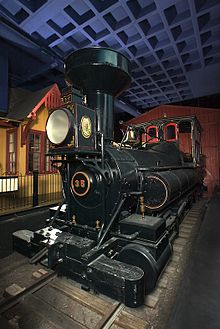Reuben Wells (locomotive)
| Reuben Wells | |
|---|---|
standard gauge | |
| Length | 35 ft (10.67 m) |
| Loco weight | 55 short tons (49 long tons; 50 t) |
| Fuel type | Wood |
| Career | |
|---|---|
| Operators | Jeffersonville, Madison and Indianapolis Railroad |
| Locale | Madison, Indiana |
| Retired | 1898 |
| Current owner | The Children's Museum of Indianapolis |
| Disposition | static display |
The Reuben Wells is a steam locomotive in the permanent collection of The Children's Museum of Indianapolis located in Indianapolis, Indiana, United States. Beginning in 1868, it operated for 30 years in Madison, Indiana, pushing train cars up the steepest "standard-gauge main-track grade"[1] in the United States.[2]
Description
The Reuben Wells is a
Historical information
The Reuben Wells was made specifically for Madison Hill, Indiana, a 1.3-mile (2.1 km) long stretch of track that is known for having the steepest regular
The Reuben Wells was completed in the railroad shops
Acquisition

In 1966, Tom Billings, head of the Children's Museum advisory board, learned that the Reuben Wells was being kept in storage in Pennsylvania. On a vacation to Washington and Williamsburg, Billings decided to stop by to see the Reuben Wells. After he saw her, he started trying to get the Reuben Wells to be permanently back in Indiana, specifically at the Children's Museum. Billings contacted Otto Frenzel, a member of the Pennsylvania Railroad board of directors, who disclosed that the railroad company was currently trying to find museums for its steam locomotives. At the time, the Reuben Wells was already promised to a museum in St. Louis. Advocates pointed out that the St. Louis museum was already getting several pieces, and St. Louis had no historical connection to the engine. The campaign was successful, and in May 1967, the Pennsylvania railroad president, Allen Greenough, announced that the Reuben Wells was coming to Indiana. She was shipped from Pennsylvania to Indiana on flatcars.[1]
The Reuben Wells entered Indianapolis with much fanfare on June 11, 1968. A parade was organized to escort the locomotive on the last leg of its journey, accompanied by the Central Indiana Council Boy Scout band and a motorcycle motorcade. The parade made its way down 38th Street and south on Meridian Street before turning into the Children's Museum. After successful fund-raising efforts from the Indiana Junior Historical Society and the Children's Museum Guild, the Reuben Wells was installed in a new train shed on the museum campus the next year. The train was moved into the new building in 1976, where it remains on view on the museum's lower level.[1] Originally acquired as a permanent loan, the Reuben Wells is now within the permanent collection of the Children's Museum.
See also
References
- ^ ISBN 9780960898206.
- ^ a b The Children's Museum of Indianapolis. "All Aboard!". Retrieved 26 February 2011.
- ^ a b "Most Powerful Locomotive Stationed Here". The Children's Museum Newsletter. February 1982.
- ^ "Old Reuben Wells Runs At Chicago". The Madison Courier. June 24, 1950.
- ^ "Reuben Wells: Famous Engine Starts New Career". Penn Central Post. August 1, 1968.
- ^ a b "All Aboard the Mighty Reuben Wells". The Children's Museum of Indianapolis. Retrieved November 21, 2021.
- ^ "Locomotive Boilers and Engines". San Diego Railroad Museum. September 6, 1999. Archived from the original on February 14, 2009.
